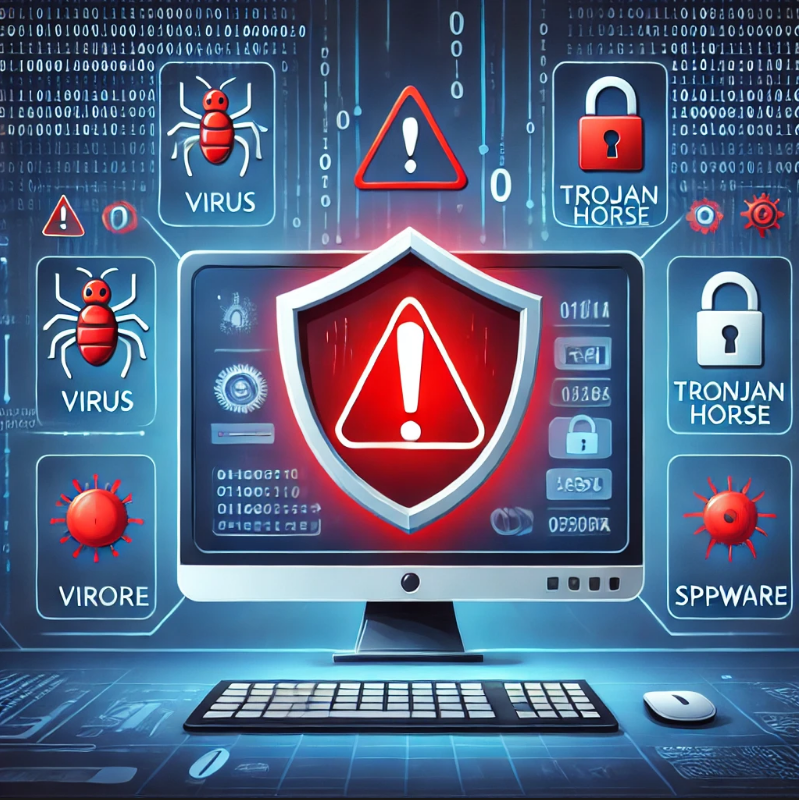First How to Spot Malware Infections ?

If you suspect your computer may be infected with malware, look for these common indicators.see how Removing Malware.
Performance Issues:
- Slow Speed: Your PC may take longer to start up, open applications, or perform tasks.
- Frequent Crashes: The system may unexpectedly freeze or crash, leading to loss of work or data.
Error Messages:
- Unusual Alerts: Unexpected error messages or system warnings could be signs of malware interference.
- System Instability: Persistent or unusual error messages can indicate underlying malware issues.
Intrusive Advertisements:
- Unwanted Ads: Excessive or pop-up advertisements that appear while browsing could suggest adware or other types of malware.
- Redirects: You may be redirected to unfamiliar or suspicious websites.
Access Issues:
- Control Panel: Difficulty accessing or modifying settings in the control panel might indicate a malware infection that is interfering with system management.
Common Types of Malware Attacks
Understanding the types of malware can help in identifying and addressing infections:
Trojan Horses:
- Function: Disguised as legitimate software, trojans can create backdoors for other malware.
- Impact: They may steal personal information or compromise system security.
Viruses:
- Function: Viruses attach themselves to files and programs, spreading to other files and systems.
- Impact: They can corrupt data, slow down the system, and lead to system failures.
Spyware:
- Function: Collects personal information without consent, such as browsing habits or sensitive data.
- Impact: Compromises privacy and can lead to identity theft.
Ransomware:
- Function: Encrypts files and demands a ransom payment to restore access.
- Impact: Can result in loss of critical data and significant financial loss.
Worms:
- Function: Replicate themselves to spread across networks without user interaction.
- Impact: They can overload network resources and spread malware.
Step-by-Step Guide to How Malware Removal Tool Works
To effectively remove malware from your computer, follow these detailed steps:
Download and Install:
- Choose a reputable malware removal tool from a trusted source. Popular options include Malwarebytes, Norton, and Bitdefender. Download the software and follow the installation instructions.
Activation:
- Use the activation key or license provided by the software service to activate the product. This may involve entering a code during or after installation.
Launch the Software:
- Open the malware removal tool from your desktop or application menu. Ensure the software is up to date to maximize its effectiveness.
Initiate a Scan:
- Start a full system scan. This process will check all files and system areas for potential threats. Depending on the size of your hard drive and the number of files, this can take some time.
Analyze Scan Results:
- After the scan completes, review the list of detected threats. The software will categorize them and provide detailed information on each item, including recommended actions.
Resolve Issues:
- Follow the tool’s recommendations to quarantine or remove the detected threats. Quarantining isolates the threats, while removal deletes them from your system.
System Cleanup:
- After addressing the threats, consider running a cleanup process to remove any residual files or temporary data left by the malware.
System Reboot:
- Restart your computer to complete the removal process and ensure that all changes take effect.
Future Prevention:
- Keep your malware removal tool updated, and consider installing additional security software like firewalls or anti-virus programs to prevent future infections.
By following these steps, you can efficiently detect, remove, and protect your computer from malware threats. Regular scans and software updates will help maintain your system’s security and performance.
CONCLUSION.
Detecting and removing malware from your computer is crucial to maintaining its performance and protecting your personal data. Key indicators of malware include slow performance, unusual error messages, intrusive ads, and restricted system access. Understanding the different types of malware, such as viruses, trojans, ransomware, and spyware, helps in identifying the threats you face.
By using reliable malware removal tools and following a systematic approach, including regular scans and updates, you can safeguard your system from future infections. Prevention measures, such as keeping your security software up to date, are equally important for long-term protection.
Regular vigilance and proactive action can significantly reduce the risk of malware infections and keep your computer secure
More things knows about T….Glicth Minds